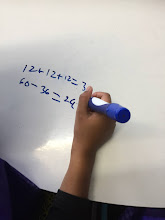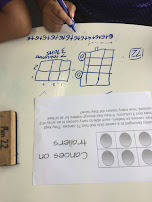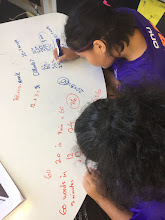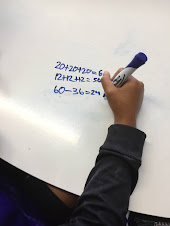Room 22 DMIC
DMIC is the acronym Developing Mathematical Inquiry Communities. Our JBS is taking advantages of this approach in teaching maths to our akonga. It is proven through the pilot research that DMIC is the quickest way to progress students in maths and it is the most advanced form of approach that can be easily applied in teaching and learning.
- taking urgency on raising the children's mathematical understanding and practice so that when they go on to secondary school and beyond all doors will be open to them
- the need to find ways of connecting children to the rich mathematical histories to be found in their cultures
Evidence in Action
- Children are often a lot more knowledgeable and capable than their teachers realise.
- Effective links are created between school learning and children's lives and identities
- If we underestimate children's abilities, we inevitably limit their opportunities to learn.
- Pedagogical practices enable classes and groups to work as caring, inclusive, and cohesive learning communities.
- Mixed-ability groups give children multiple opportunities to learn from each other.
- For many children, a collectivist approach to learning ('no-one gets left behind) is more effective than a competitive approach.
- Children appreciate having agency in their own learning.
- Maths is about being able to explain how the answer has been arrived at as well as getting the answer.
- Children need to be taught how to work productively and respectfully together.
- Seeing outside expertise working with their own children can create dissonance in teachers, causing them to question existing theories and becoming a catalyst for substantive change.
- Effective maths teaching involves careful preparation: to generate worthwhile problems that build on children's proficiencies, to connect to big mathematical ideas, and to anticipate children's mathematical thinking.
- Teachers become students of their own students, learning to use children's thinking as a springboard for further learning.
- Teachers can find it beneficial to prepare collaboratively.
Mixed ability grouping
- the role that school leadership can play in recognising the need for, initiating and supporting pedagogical change
- the use of demonstrated external expertise to create dissonance that leads to productive change
- the 'how' of scaffolding reciprocal or alternating tuakana teina roles in student group work
- effective mixed-ability grouping as a key to accelerating improvement and promoting equity
- Respectful engagement with teachers when existing theories are being challenged.
Because ability grouping has for so long been accepted as the norm in New Zealand schools:
- it is what parents expect (and often want)
- expertise in working with mixed-ability groups is limited
- shifting to mixed-ability groups can generate huge initial dissonance for teachers
- the experience of DMIC teachers and leaders is an important resource for supporting colleagues contemplating the shift.
Using mixed-ability grouping requires expert pedagogical and curriculum content knowledge, and the capability to work simultaneously and effectively with diverse learners.
Problem and launch
- Problems need to be carefully designed so that:
- the children will understand what it is they are trying to solve
- they connect to big, worthwhile maths ideas
- they connect in some way to the lives/communities of the children
- Devising good problems is best done collaboratively
- pedagogical leaders 'talk the walk'
- meetings optimise coherence, value and impact of pedagogical design
- choice of problems is linked to the curriculum
- exploration of possible misconceptions
- An effective launch ensures that:
- the problem makes sense to the students
- the problem matters to the students
- Pedagogical leadership.
Learning to listen
- By listening to the children, teachers can learn how to improve their teaching
- Instead of telling, teachers support children's learning by asking the right questions
- Teachers can elicit questions from children that will support the learning of the group
- A shift from mostly teacher talking to mostly children talking greatly increases learning by both children and teacher
- Students have opportunities to resolve cognitive conflict
- Children love that they can make school learning their own by having learning conversations with each other.
Teacher development
- A shift in mindset has been required of both teachers and students
- Teachers have had to develop new pedagogical knowledge
- The focus in the second year is on embedding the pedagogy in classrooms
- School leadership is now working to reduce dependence on external facilitation
- Internal staff ownership and pedagogical leadership are keys to ongoing improvement.
Strategies include:
- Peer observations in each other's classrooms
- Collaboration that involve open discussion, critique and support
- Lesson study:
- A group of teachers plan the lesson
- One teacher teaches while the rest of the group observes
- The group critiques each part of the lesson to see how it could be improved
- Another teacher teaches the lesson, drawing on what has been learned through the group critique.
Impacts
- The importance of high expectations for all children, supported by effective scaffolding
- The need to nurture educationally powerful connections to rich histories of mathematics in children's own cultures
- Positive social norms in mathematics can be transformative of classroom culture across the curriculum
- The shift in teacher practice can strengthen student agency, collaboration and leadership.
Group norms
- Creating new social norms for productive collaboration is a major endeavour
- A collaborative, respectful whānau model informs the values on which the group norms are based; teaching and learning practice consistently exemplifies these values
- Children need to be explicitly taught the 'how' of productively participating and contributing
- The 'talk moves' provide a framework for productive engagement that can be taught to, internalised, owned and propagated by children.
- Shared responsibility for each other's learning goes hand-in-hand with high expectations of each other: no passengers, everyone will explain clearly, no one gets left behind
- The group is responsible for ensuring that each member can explain and justify the strategy used. A 'one pen per group' policy supports productive collaboration.
- When well-implemented, DMIC leads to accelerated improvement in literacy as well as mathematics.
Learning for life
- setting maths in meaningful contexts is a key to engagement, understanding and agency
- children like to have agency in their own learning
- working on 'real' problems builds agency.
This reinforces the crucial importance of good problem design and teaching children how to work productively in collaborative, mixed-ability groups.
Speaking of their experience of DMIC maths, the children say:
- working on problems that are situated in real life is a good way to learn about life
- it's great to have opportunities to do your own thinking and come up with your own strategies
- it's great to be challenged
- sharing thinking gives you opportunities to learn from others
- mistakes are opportunities for learning.
Effective implementation of DMIC gives students confidence in their ability to do challenging mathematics.
Learning together
- Working in mixed ability groups exposes you to a variety of possible approaches, gives you choices
- Listening to other people's ideas and reflecting on your own ideas are important for learning
- Sharing your thinking with others is worthwhile for you, too
- The 'talk moves' are a useful means for supporting group members to share and clarify their thinking
- We like being able to take over some of the role that teachers have traditionally had
- We can ask other students (not just the teacher) questions
Perspectives
- As teachers/leaders we don't know what we don't know, so we need opportunities to check our thinking with someone who knows/understands more than we do
- Core Pasifika values are at the heart of Pasifika Maths/DMIC
- In-class modelling is a powerful tool for challenging existing theories and creating dissonance. By observing Bobbie in action in the classroom, teachers realised that their children were capable of a lot more than they had imagined and that their own low expectations had been limiting their opportunities to learn
- It is highly motivating to see theory in action, especially with our own students, and even more so to see the theory working successfully the first time
- In-class mentoring and co-construction enables gaps in teacher knowledge to be addressed in a timely way
- It's a journey, and teachers learn best when they feel they are in a safe and supportive environment.
It’s a journey
- You have to become uncomfortable with how you are teaching before you can become a more effective teacher
- It is important that the level of discomfort is not so high that you give up
- Teachers come to understand how to better teach mathematics through developing their own content knowledge, understanding children's learning processes and anticipating children's misconceptions in mathematics
- Teaching maths effectively requires major investment in preparation time, particularly to construct problems that meet multiple criteria
- Challenge, in-class modelling and mentoring from external experts, managed in a safe and caring manner, are powerful tools for demonstrating what is possible, creating dissonance and supporting teacher change
- The DMIC lesson framework (launch, problem-solving in groups, connect) imposes discipline on planning and teaching, but getting each phase right requires practice
- It is good for children to see their teachers as learners: taking risks, making mistakes, accepting feedback
- The move from teaching based on fragmentary learning intentions to learning that connects to big mathematical ideas is very important and can involve a major mind shift
- Uncertainty about what the big mathematical ideas are is stressful for teachers, especially those who are not secure in their content knowledge
- The 'connect' at the end is powerful because that is where the learning is consolidated
- Once children realise that mistakes are part of learning they are happy to take risks and to question and share
- Learning, whether by the children or teacher, thrives in a safe and supportive environment.
Culturally responsive pedagogy
- Assumptions based on our own experiences and cultural mindset create barriers to learning for children who don't share them and can't relate to them
- Children learn best in environments where their identities are valued
- Teaching effectively requires forging educationally powerful connections to students' lives and identities
- Children engage productively with maths when problems are set in contexts that they can relate to and understand
- Learning requires active participation, so children from cultures that do not encourage questioning or putting forward ideas, for example, need to be actively supported to overcome these inhibitions
- Mistakes have to be repositioned as a necessary and valuable part of learning if children are to be willing to take the risks that learning entails
- Caring for students can mean making them uncomfortable by pushing them to think (pressing them for understanding) and to publicly contribute their thinking
- Pasifika students learn best in a supportive collective characterised by reciprocal benefits and responsibilities. Parallels between a whānau and a community of learners can be leveraged.
- When supposedly 'low' students are exposed to mixed-ability, challenging maths, they can surprise teachers
- Ambitious teaching gets far more out of students than low expectations
- Negative attitudes towards maths are not inevitable. Once they get over the initial shock, children love to be challenged and to be active participants in their own learning.
Fundamental shifts
- When supported by effective pedagogy, heightened expectations lead to increased achievement
- The belief that some children will never succeed needs to be replaced by the belief that all will 'get there' if certain things happen
- When internal dialogue is externalised it can be examined
- Effective maths teaching puts less emphasis on doing mathematical activities and getting the answer and more on explaining and justifying
- By listening more, teachers become more aware of what/how the children are thinking at the same time as they provide a space for the children to do the explaining
- Asking the right questions is more productive of learning than rescuing
- In effective mixed-ability groups members are held jointly accountable for understanding and, if called on, any member can explain and justify the group's thinking
- Children develop positive maths identities when supported to assume greater agency in their own learning
- If children are questioning, thinking, and taking responsibility for themselves in maths, chances are they'll be acting similarly in other contexts

























DMIC, in my opinion has the potential to enrich teachers with a pedagogy to approach students with maths in a way that suits their interests and needs. Students do not need to right all the time with their strategies and answers. This approach gives freedom to the students to do their best and no need to worry about the outcome.
ReplyDelete